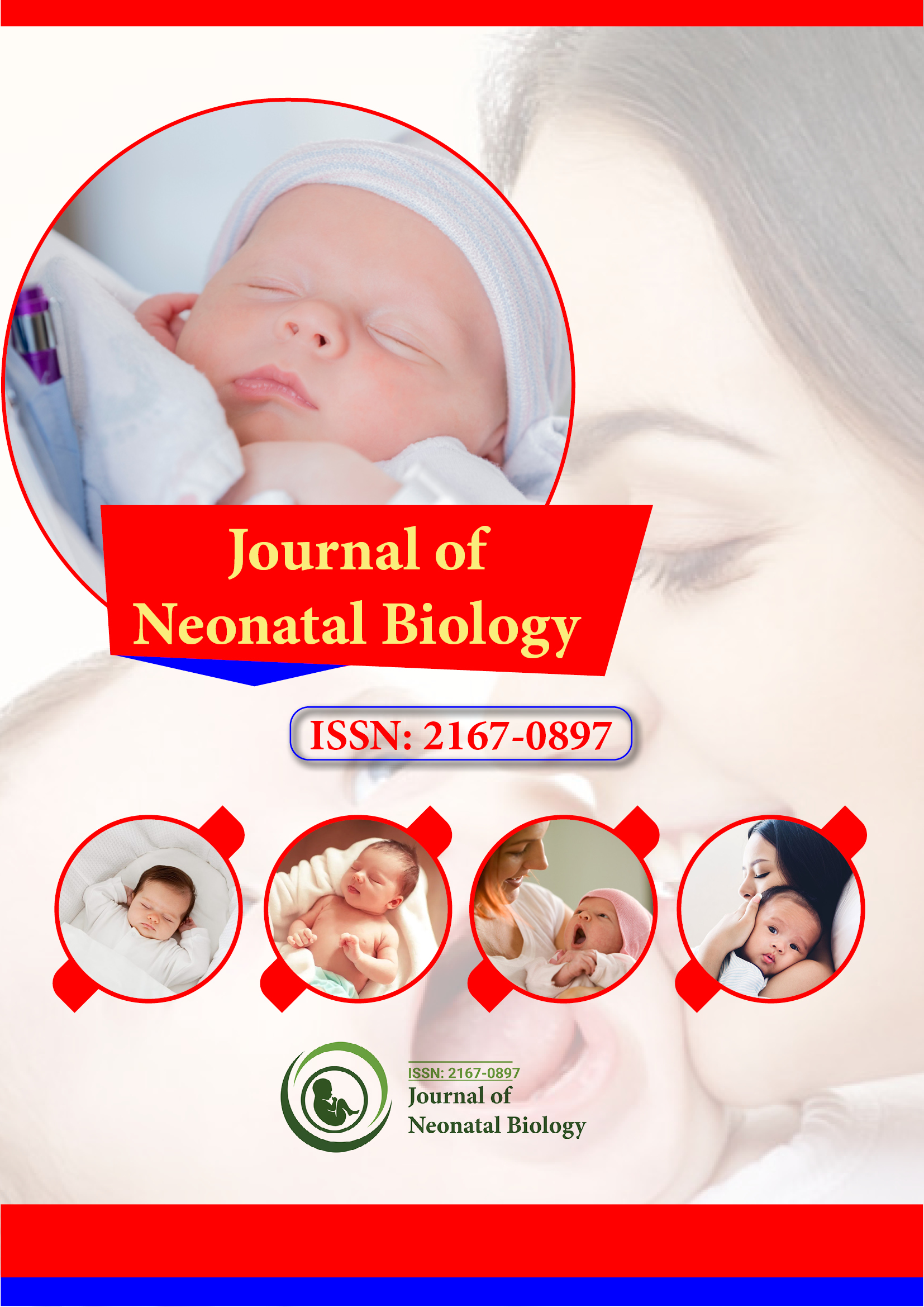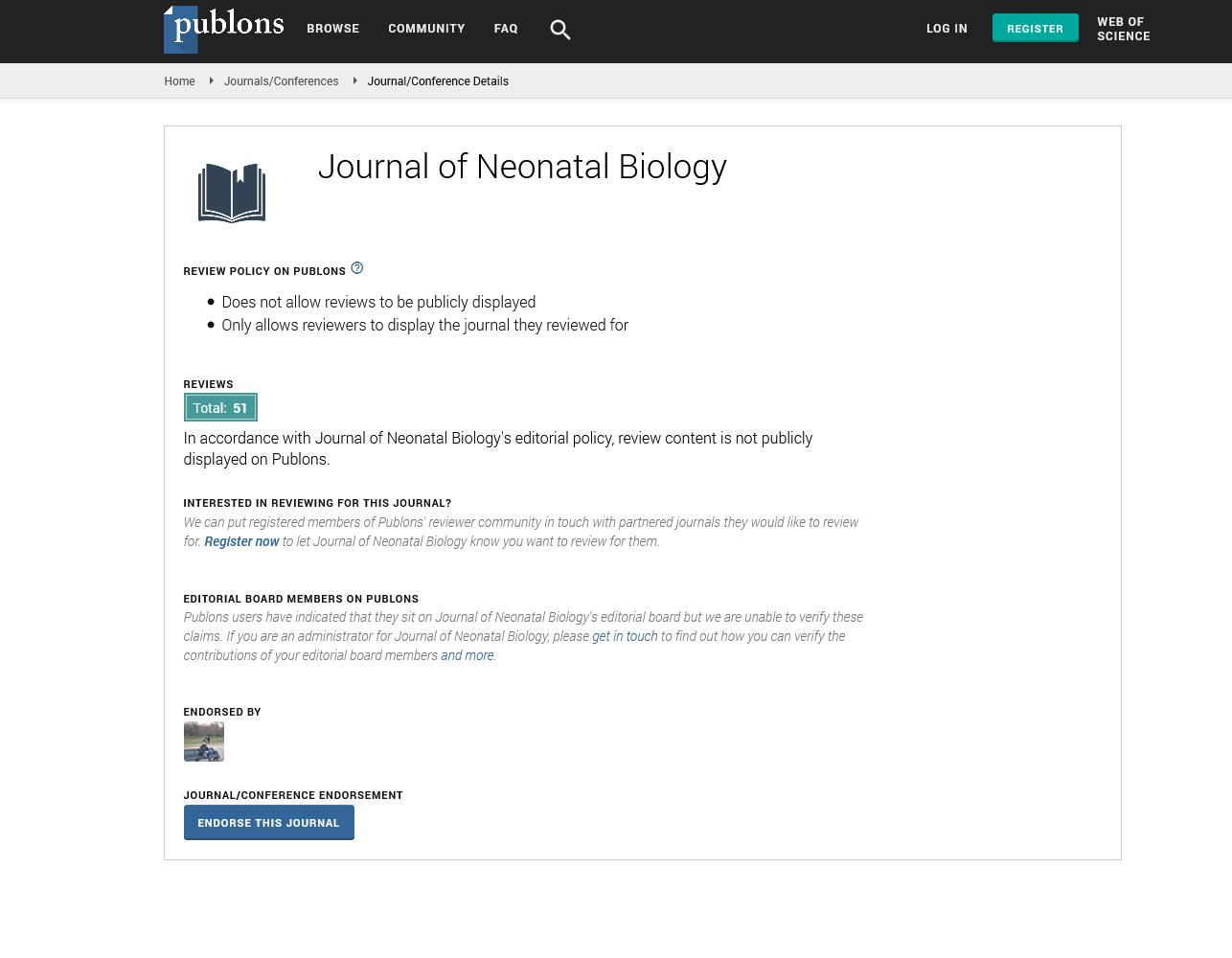Indexed In
- Genamics JournalSeek
- RefSeek
- Hamdard University
- EBSCO A-Z
- OCLC- WorldCat
- Publons
- Geneva Foundation for Medical Education and Research
- Euro Pub
- Google Scholar
Useful Links
Share This Page
Journal Flyer

Open Access Journals
- Agri and Aquaculture
- Biochemistry
- Bioinformatics & Systems Biology
- Business & Management
- Chemistry
- Clinical Sciences
- Engineering
- Food & Nutrition
- General Science
- Genetics & Molecular Biology
- Immunology & Microbiology
- Medical Sciences
- Neuroscience & Psychology
- Nursing & Health Care
- Pharmaceutical Sciences
Short Communication - (2024) Volume 13, Issue 2
Automated Analysis of the Moro Reflex: Early Detection of Neurological Problems
Renaud Matton*Received: 01-May-2024, Manuscript No. JNB-24-26099; Editor assigned: 03-May-2024, Pre QC No. JNB-24-26099 (PQ); Reviewed: 17-May-2024, QC No. JNB-24-26099; Revised: 24-May-2024, Manuscript No. JNB-24-26099 (R); Published: 31-May-2024, DOI: 10.35248/2167-0897.24.13.455
Description
The Moro Reflex (MR), also known as the startle reflex, is an important neurological indicator in newborns. Typically observed in response to a sudden loss of support or loud noise, this reflex is characterized by the infant spreading their arms, arching their back, and then bringing their arms together as if embracing. The presence and quality of the MR are potential markers of neurological integrity in infants. Accurate evaluation of this reflex can be particularly significant in late preterm (34-36 weeks gestation) and term infants.
Importance of the mono reflex
The MR emerges around the 28th week of gestation and is fully developed by 34 weeks. It typically disappears by the age of 4 to 6 months. The reflex is believed to be a primitive survival mechanism. Its presence at birth and appropriate integration as the infant matures are indicators of normal neurological development [1].
An abnormal MR can signal a variety of neurological problems. A weak or absent reflex may suggest Central Nervous System (CNS) depression, whereas an asymmetric MR might indicates brachial plexus injury or hemiplegia. Thus, evaluating the MR accurately is potential for early detection and intervention of potential neurological issues [2].
Traditional assessment methods
Traditionally, the MR is assessed through manual maneuvers performed by healthcare professionals. The infant is held in a supine position, and the examiner quickly but gently allows the head to drop back slightly, observing the subsequent reflex response. The assessment focuses on the symmetry, strength, and duration of the reflex [3].
Subjectivity: The assessment relies heavily on the examiner’s experience and interpretation, which can lead to variability in results.
Stress for infants: The maneuver can be stressful and uncomfortable for newborns, potentially affecting the reflex response.
Inconsistency: Different examiners might employ slightly different techniques, leading to inconsistent evaluations.
Objective methods for evaluating the moro reflex
Given the limitations of traditional assessment methods, there is a growing interest in developing objective techniques for evaluating the MR [4]. Objective methods can reduce subjectivity, improve consistency, and provide quantifiable data for better clinical decision-making. These methods typically involve advanced technologies such as accelerometers, video analysis, and automated scoring systems.
Accelerometry: Accelerometers are devices that measure the acceleration of a body part. When used to assess the MR, accelerometers can be attached to the infant’s limbs to record the movements during the reflex response. These devices provide precise, quantitative data on the amplitude, velocity, and coordination of the reflex movements. Advantages of accelerometry includes precision, provides accurate measurements of the reflex components. It provides objective data that can be compared over time or across different populations, causes minimal stress to the infant [5].
Video analysis: High-speed video analysis is another objective method for evaluating the MR. This technique involves recording the reflex response with a high-speed camera and analyzing the video frame-by-frame to assess the reflex characteristics. Software can be used to automate the analysis and provide detailed reports on the reflex components. Advantages of video analysis includes detailed observation allows for comprehensive analysis of the reflex response. Repeatability enables repeated assessments without additional stress to the infant. Objective scoring reduces subjectivity through automated scoring systems [6].
Automated scoring systems: Automated scoring systems combine data from accelerometers, video analysis, and other sensors to provide a comprehensive evaluation of the moro reflex. These systems use algorithms to analyses the data and generate objective scores that reflect the reflex quality. Advantages of automated scoring systems includes integration which combines multiple data sources for an important assessment. Standardization ensures consistent evaluation across different examiners and settings. Efficiency provides quick and reliable results, facilitating timely clinical decisions [7].
Clinical implications and future directions
The use of objective methods for evaluating the MR has significant clinical implications. By providing precise and consistent assessments, these methods can improve the early detection of neurological abnormalities in late preterm and term infants. Objective evaluations can also facilitate research into the development and variations of the MR, leading to a better understanding of its clinical significance [8].
Incorporating objective methods into routine clinical practice requires addressing several challenges. Accessibility ensuring that advanced technologies are available and affordable for widespread use. Training healthcare professionals to use and interpret data from objective assessment tools. Validation conducts further research to validate the reliability and clinical utility of these methods [9].
Future directions in this field may include the development of portable and user-friendly devices for use in various clinical settings, as well as the integration of Artificial Intelligence (AI) to enhance the analysis and interpretation of reflex data [10].
Conclusion
The moro reflex is a potential indicator of neurological health in newborns. While traditional assessment methods have limitations, objective methods such as accelerometry, video analysis, and automated scoring systems provides significant advantages. By providing accurate, consistent, and quantifiable data, these methods can improve the early detection of neurological issues in late preterm and term infants, leading to better clinical outcomes and informing future research. As technology advances, the integration of objective methods into routine practice facilitates for enhancing neonatal care.
References
- Ince DA, Ecevit A, Yıldız M, Tugcu AU, Ceran B, Tekindal MA, et al. Evaluation of Moro reflex with an objective method in late preterm and term infants. Early Hum Dev. 2019;129:60-64.
[Crossref] [Google Scholar] [PubMed]
- Fredrickson WT, Brown JV. Gripping and moro responses: Differences between small-for-gestational age and normal weight term newborns. Early Hum Dev. 1980;4(1):69-77.
[Crossref] [Google Scholar] [PubMed]
- Rönnqvist L. A critical examination of the moro response in newborn infants-symmetry, state relation, underlying mechanisms. Neuropsychologia. 1995;33(6):713-26.
[Crossref] [Google Scholar] [PubMed]
- Zafeiriou DI. Primitive reflexes and postural reactions in the neurodevelopmental examination. Pediatr. Neurol. 2004;31(1):1-8.
[Crossref] [Google Scholar] [PubMed]
- Overvelde S. Guiding parents of children with persistent primitive reflexes. J Nurse Pract. 2024;20(6):105021.
- Ludwig RJ, Welch MG. How babies learn: The autonomic socioemotional reflex. Early Hum Dev. 2020;151:105183.
[Crossref] [Google Scholar] [PubMed]
- Rousseau PV, Matton F, Lecuyer R, Lahaye W. The moro reaction: More than a reflex, a ritualized behavior of nonverbal communication. Infant Behav. Dev. 2017;46:169-177.
[Crossref] [Google Scholar] [PubMed]
- Futagi Y, Toribe Y, Suzuki Y. The grasp reflex and moro reflex in infants: Hierarchy of primitive reflex responses. Int J Pediatr. 2012;2012(1):191562.
[Crossref] [Google Scholar] [PubMed]
- Jayasheel A, Chandrasegaran B, Kumar VB, Babji NS. Evaluation of modified extended sick neonate score to predict in-hospital mortality among newborns admitted to resource-poor settings in rural India. Indian J Pediatr. 2023;90(4):341-347.
[Crossref] [Google Scholar] [PubMed]
- Ong WJ, Baral VR, L Ereno I, Sultana R, Yeo CL. Comparison of the neurobehavioural profile of early‐preterm infants against term and late‐preterm infants using the hammersmith neonatal neurological examination. J Paediatr Child Health. 2023;59(1):72-80.
[Crossref] [Google Scholar] [PubMed]
Citation: Matton R (2024) Automated Analysis of the Moro Reflex: Early Detection of Neurological Problems. J Neonatal Biol. 13:455.
Copyright: © 2024 Matton R. This is an open access article distributed under the terms of the Creative Commons Attribution License, which permits unrestricted use, distribution, and reproduction in any medium, provided the original author and source are credited.

